
SKOPELOS
GETTING THERE
Due to there being no airport on Skopelos, you’ll need to reach Skopelos by ferry, either from Volos, Thessaloniki or from Skiathos depending on which airport you fly into. Ferries between Volos and the Sporades islands are operated by Hellenic Seaways, Anes Ferries, Blue Star Ferries and Aegean Flying Dolphins. It’s worth comparing the different operators as they vary in price, vessel and journey time.

Coming from Skiathos, it’s easier to just drop the car at the rental desk at the port in Skiathos and pick up another at the port in Skopelos. Alma has a rental desk at both ports and there’s a large, free car park on the harbour front in Skopelos so always somewhere to park if you are going into town.

Skopelos is characterised by its dense forests and the blue of its seas and was formally declared a blue and green island in 1997 by the International Organisation of Biopolitics. More than 67% is covered by lush virgin pine forest. it’s magical, and the landscape changes as the light change throughout the day. During your stay you must witness sunrise at the castle in Chora and sunset at Loutraki harbour… the rest is the icing on the cake!
MYTHS, LEGENDS AND A LITTLE BIT OF HISTORY
The myths and legends with gods, semi-gods, mythical kings, pirates, dragons and saints give the image of the island its mystical dimension.

All these myths began from when Peparethos, the son of Ariadne and Dionysus and grandson of Minos, the king of Crete, gave his name to the island; from when his brother, Stafylos, first resided on the island in the years of the Minoan Thalassocracy; from when Dionysus reigned in the culture and the tradition of Peparethos, to form the belief that wine was used to build houses and churches; from when a dragon dominated Skopelos, until its Patron Saint Riginos killed him.
On Skopelos you will find over 40 monasteries dotted around the island, all with important history and most located in places with breath-taking views. Just around town there are 14 so you don’t have to go far to visit them.

The monastery dress code is for both men and women to cover shoulders and ideally knees so if you plan to visit the monasteries you may want to take a wrap, easy to put on an take off and take up no room in your bag.
The Monasteries tend to open for visitors in the morning until around 1pm and then open again in the evening 5pm to 8pm.

On the pine clad eastern side of Skopelos are a string of monasteries which you can visit by car or hike. From the eastern end of the port, a marked footpath leads up the slopes of Mount Palouki, skirting villas, crossing the winding road and leading through forest until you arrive at the 16th century Monastery of Iera Moni Sotiros.
Not much further is the Monastery of Timios Prodromos, with an open outer courtyard and a small church within the walls. And a bit further along the trail you would arrive at the Vizantino monastery.

Shortly before reaching Glossa on your right you will see a road that leads to the Chapel of Ai Giannis at Kastri. It’s perched on top of a rock 100m high with approx. 200 steps cut into the rock to get there, but spectacular and worth the climb if you are fit enough.
Your first sight of Skopelos will be Skopelos Town, also known by the locals as “Chora” which simply means “Town” in Greek. Arriving by ferry, you get a great view of the pretty houses rising up from the port, built in the Venetian style, with balconies and terracotta roof tiles. Connecting them is a network of narrow stone paved paths, ideal for wandering on foot – built for mules rather than cars.
Skopelos, like Skiathos, is a small island, so wherever you stay it’s easy to get around, especially with your hire a car. There are several beautiful beaches with good road links, a plethora of tavernas and a range of accommodation options. Alternatively, you could stay in Skopelos town with its lively harbour front and use it as a base to visit different beaches and other attractions daily.

Chora has a wide range of accommodation, from mainstream hotels to pretty apartments and studios in the narrow streets of the old town. There is a small-town beach but it’s nothing compared to the stunning beaches in other parts of the island, so if you are wanting to stay near or on the beach, the town centre is not ideal. but if you are looking for the night life, then town is definitely the base for you.
In Chora if you walk further along the harbour past all the tour boats, past the fishing boats and climb the steps to the Church of the Virgin Mary at the furthest end of the harbour. Continue uphill past two more small churches and you’ll arrive at the ruins of the Venetian Castle, which gives you great views over the town and has a cafe to sit at the top and admire them. Skopelos town is a great place to shop for holiday essentials, with plenty of food shops and the best choice of restaurants etc.
Neo Klima on the south coast of Skopelos is a small town and resort, with a pretty marina where you will find a couple of long beaches and plenty of accommodation options, mainly studios and villas – and of course well placed for a boat trip! This is a good alternative on the south coast to Panormos and has easy access by car to Skopelos Town, Glossa and the other south coast beaches such as Milia and Kastani.

Glossa itself has very narrow streets with no space for parking a car and it’s easier just to visit for a couple of hours. However, you could stay just below the town by the sea at Loutraki. Here you will find hotels and a range of self catering apartments and studios, with a few tavernas and easy access to the ferry which regularly arrives in the port.
Don’t attempt to take your car into or through the town, whatever Google Maps may tell you! Parking is limited, but there is a small parking area at the church as you come into town, or you can park on the main road just below the town that leads down the hill to Loutraki, then walk up into Glossa. A visit here is all about soaking up the atmosphere, exploring the pretty streets with stunning sea views all round – and of course you can stop for a coffee or have lunch whilst you are there. Perfect place for photos!
From Skopelos town, it’s a short drive to the south side of the island and the pretty fishing port of Agnontas. This is the ideal place to come for a long, lazy lunch followed by a swim, with a couple of fish tavernas on the sea front and small beach for swimming. We walked right along the long pier where there were numerous yachts moored up, a favourite with sailors visiting the North Sporades archipelago.

If you continue along the small road at the end of town that follows the coastline, there are numerous rocky swimming spots along the Amarandos Cape. Two pines sitting on top of a rocky outcrop with a turquoise inlets below, make one of the most photographed shots of Skopelos, a location used in the Mamma Mia film when Sophie spends an afternoon sailing with her three fathers.
In the opposite direction a small coastal road takes you around the cliff to the beautiful and popular beach at Limnonari where there are two more beach tavernas and plenty of sun beds.
Just up the coast from Panormos are the pretty beaches of Milia and Kastani, the latter much visited
since several scenes from Mamma Mia were filmed there. Kastani is where some of the singing and dancing filming was made – Sophie and Sky sang “Lay all your love on me” on Kastani and on the other side of the beach is where they shot “Does your mother know?” The sheltered coves of Limnonari and Stafylos on the south coast, Glysteri on the north coast which is closest to Skopelos town and the small but pretty Agios Ioannis beach, set below the Mamma Mia chapel are probably the most beautiful beaches, but check out and see for yourself.
MAMA MIA!
Ever since Skopelos was used in 2007 as the main location for the film Mamma Mia, tourists have been flocking to re-live the Greek island fantasy and sing along to those catchy Abba songs. Many of the interior scenes were shot at the Pinewood Studios near London (spoiler!), but you can visit several gorgeous beach locations in Skopelos and especially the chapel of Agios Ioannis that featured in Sky and Sophie’s wedding. Perched on top of a rock, the climb up the 202 steps to the tiny chapel rewards you with views over the stunning rocky coastline and beach below. Due to the miniature size, a much larger version of the chapel interior was built in the Pinewood Studios to use for the wedding scene.

Parking is at the bottom of the hill along the road in front of the beach café. The cafe also serves food and drinks on the beach and rents the beach beds and umbrellas. There’s also a small shop nearby called Sporades cosmetics that sells natural beauty products – remember to check it out.
After climbing up to the chapel (it’s free but donations are appreciated) you can walk down to the beach and cool off in the clear turquoise waters. Other beaches that were used as film locations for Mamma Mia were Kastani and Glysteri – of course they chose the best, why wouldn’t you. Can you imagine having the job of finding the best beaches in Greece for the movie, what a fantastic reccie that would have been! Did we tell you we have also been to Vai beach in Crete where the original Bounty advert was filmed? (another spoiler coming up – the palm trees on Vai beach are date trees, not coconut so the coconuts had to be hung on the trees 😊 and they had to import the sand, it’s a shingle beach)

Glossa is the second largest town on Skopelos, situated on the northeast coast on the hillside above the seaport of Loutraki, which is an alternative stop for the ferries and flying dolpins enroute for the port of Skopelos. It’s a charming traditional village with narrow winding streets, pretty traditional houses and gorgeous pops of colour in the painted shutters and bougainvillea.
Combine your visit to Glossa with a stop at Loutraki, the sea port that sits below it, although you might want to avoid the times when the ferry is due to call as it will then be quite busy. At other times it’s a sleepy little place with a pretty harbour and a couple of tavernas where you can have a coffee or nice lunch.
In Skiathos we included a bit of exercise and we did the same for Skopelos, and went in search of the ancient tombs at Sentoukia on Mount Karia. They are locally known as the “Pirate Graves” and stories are told about the pirates who used to attack and plunder these islands being buried here along with their treasure.. The reality is that very little seems to be known about these tombs cut into the bedrock and topped with enormous stones that have been pulled back by grave robbers.
There are 3 complete tombs next to each other and a fourth that is started but not completed and set on the top of the hill, with a view over the sea, these must have been the tombs of someone very important indeed! Sadly the contents of the graves have long since disappeared and the pirate story seems to be the only thing that remains. The stories of pirate ghosts watching over their graves and treasure is a bit of local folklore that’s been embroidered for the tourists but it makes for a great story, who knows if it’s true, and why does it matter?

From Skopelos town, it’s a short boat trip across to the neighbouring island of Alonissos where there’s a National marine park surrounding the island encompassing the smaller uninhabited islands nearby. You may well get to see mediterranean monk seals, dolphins and native sea birds as well as having the chance to do some snorkelling and swimming in the beautiful clear waters.
And it would be remiss of us to not talk about the glorious traditional food you can find on Skopelos! Skopelos is famous for its plums which are dried to make prunes and juice and exported all over the world. You can see them in local delicatessens and on restaurant menus where they may be served in a dish of pork or rabbit, slow roasted with prunes. Local honey is widely available and used to drizzle on deserts or drench almond cakes. Local fruits are preserved in syrup to make the “sweet spoon” that is offered to guests when they visit a home in the afternoon. (Loads to talk about but we would have failed if we had not mentioned food!)

Another notable specialty of Skopelos is the Strifti pie, coiled into a spiral with a filling of goats cheese or spinach and deep fried, a variation on the traditional Tiropita cheese pie. Also worth a visit when you’re in Glossa is the Antoniou Family Olive Oil museum and olive mill on the outskirts of town, where you can taste and buy their cold pressed olive oil made from the local fruit.
So this is the end of our visit to Skopelos, not sure where we are heading yet so check back in to find out.
The borders are open – let’s get travelling and help get tourism off it’s knees and back on it’s feet again!
Happy travels!






